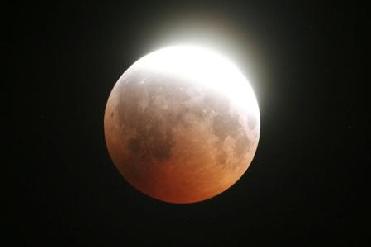
A partial lunar eclipse
NEW DELHI (PTI): A double celestial treat awaits sky gazers as a partial lunar eclipse and opposition of Pluto will be visible Saturday.
The penumbral eclipse will begin at 1427 hours and end at 1949 hours, while the partial phase of the eclipse will start at 1546 hours and end at 1829 hours, R C Kapoor, a researcher at Indian Institute of Astrophysics, told PTI.
The eclipse will be visible in eastern Asia, Australia, Antarctica, parts of America, Indian and Pacific oceans, he said. In eastern Asia, people in India, Nepal, Singapore and Malaysia among others will be able to see it at the moon-rise only.
Parts of northeast India will witness the moon rising in the eclipse, whereas rest of the country will be disappointed.
The eclipse will be at maximum at 1708 hours. During the phenomenon, 53 per cent of the moon disc will be covered by the umbral or the dark part of the earth's shadow.
The entire event can be watched with naked eyes but a binocular or a telescope may provide a detailed vision.
According to Kapoor, lunar eclipses are safe to look at because the moon only shines by reflecting sunlight -- the intensity of its radiation is quite low.
On eclipse night, the moon will lie in the constellation Sagittarius -- the archer. The next lunar eclipse will occur on December 21.
A lunar eclipse occurs when the earth is in a direct line between the sun and the moon, and the shadow of the earth falls on the moon, president of NGO Science Popularisation Association of Communicators and Educators C B Devgun said.
The other phenomenon will be Pluto at opposition.
Opposition in astronomy means when a celestial object is on the opposite of the sky from the sun, when viewed from the earth.
Pluto will be visible almost all the night, rising around the sunset, culminating around midnight and setting around sunrise as its orbit brings it closest to the earth, making it appear bigger and brighter.
The second dwarf planet will be visible at 0030 hours Saturday with a magnitude of 14.
During the opposition Pluto will be 30.843 astronomical unit (4,626,450,000 kms) away from the Earth.
To watch the event, one will need a telescope, with aperture at least 25 cm.
 Previous Article
Previous Article Next Article
Next Article












The Indian Air Force, in its flight trials evaluation report submitted before the Defence Ministry l..
view articleAn insight into the Medium Multi-Role Combat Aircraft competition...
view articleSky enthusiasts can now spot the International Space Station (ISS) commanded by Indian-American astr..
view article